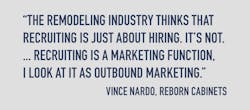Somewhere in the Sierra Nevada, along the celestial blue shores of California’s Lake Tahoe, Dave Baker, general superintendent for Reno, Nev.-based Dianda Construction, is watching four skilled carpenters rapidly frame a large interior wall that is part of a 19,000-square-foot remodeling job. As he observes his crew, a wide smile crosses his face. “I feel lucky as heck to have these guys. They are the cream of the crop,” says Baker, a master carpenter with 40 years of experience. “Since we’ve hooked up with a recruiter, we’ve been able to find temporary help when we need it. This project right here has four very skilled carpenters working on it that our recruiting firm found for us.”
Dianda Construction, a high-end building and remodeling firm in business for seven years, counts 40 construction professionals among its full-time staff. Like many others in the industry, the company has faced challenges with an ongoing labor shortage. And, also like many successful remodeling companies across the country, Dianda relies on its excellent reputation to a attract repeat and referral business. Using substandard carpenters, inexperienced project managers, second-rate designers, or unlicensed plumbers is out of the question.
That’s why, roughly two years ago, the firm hired a professional recruiting agency, Trillium Construction, to help it solve its labor issues. Trillium is a national staffing agency that specializes in finding qualified tradespeople for every conceivable position within the construction industry. “It’s worked out very well for us. They do a good job finding us great workers, and we’ve been very happy with them,” Baker says.
A Popular Choice
Across the country, recruiters’ phones are ringing. “We get at least seven calls looking for plumbers or electricians on a daily basis. And it’s notJust outside St. Louis, Richard Latas, president of Michael Latas & Associates, has also seen a spike in requests for construction labor. Established in 1975, Latas and his firm provide recruiting services exclusively for the construction industry.
“When I get a call from a residen al construc on client, the need is critical,” he says. “A company will call me because all of a sudden they have a hole in their job crew, and they have an active project. This means they’re losing money every day. It’s a very serious situation.”
In Roseville, Calif., Frank DeSafey, president and principal for Sequence Staffinng, echoes the experience of other recruiting firms specializing in construction and remodeling. “We’re witnessing a surge in demand. It’s not like 2004 again, but it feels like we are approaching that level in terms of demand. Over the past year, we’ve had a tremendous increase in requests from companies seeking skilled construction labor,” DeSafey says. “The skill sets needed in the industry are in such short supply, [and there’s] a huge demand for these skills.”
What Should Remodeling Firms Look for in Recruiters?
There are literally thousands of staffinng and recruiting agencies across the U.S., according to data from the American Staffing Association, and knowing how to select one can be daunting. Hiring experts advise remodelers to perform some basic research and careful analysis of recruiters before signing a contract or paying a retainer.
- Does the recruiter understand your company’s culture?
- Does the recruiter have a good handle on the scope of the project and the talent required to successfully complete the job?
- Does the recruiter have experience working with the construction industry?
“I am always amazed when a construction company looks for skilled labor through a corporate recruiting firm. These firms don’t understand construction,” DeSafey says.
According to Latas, who has specialized in the construction industry for nearly 40 years, remodeling companies also need to understand how recruiting search assignments are performed before signing a retainer agreement. Michael Latas & Associates, for example, hunts from a database representing hundreds of qualified workers and profitable, aggressive construction firms. This resource not only increases the firm’s placement odds, it also provides insight into the construction industry as a whole, regional pockets of activity, the type of workers who are out there, and specialties they provide.
“We have built an extensive database of highly qualified workers and construction companies since 1975,” Latas says. “We’ve been in this business a long me, and so we have accumulated really great information. Nobody can buy it, and nobody can access it.”
How Much Does a Construction Recruiting Firm Cost?
Given the labor shortage, it shouldn’t be surprising that the cost of retaining a recrui ng firm isn’t cheap. The recrui ng industry customarily uses two different payment structures depending upon whether a company is looking for a temporary or permanent placement.
Hiring temporary help. For temp help, the recrui ng firm and the construc on company must first agree upon a rate for a particular skillset. The construction company pays that rate directly to the recruiting firm, which then pays the talent. When hiring temporary help, the recruiting firm manages all of the human resource details.
“When we find temporary help, we handle all of the payroll, workers’ compensation, taxes, everything. The client never has to worry about anything but the project at hand,” Trillium’s Hopen says.However, if the construction company decides to hire the worker permanently, the company must pay the full price of the temporary contract, plus a fee based on the worker’s annual salary for the first year. This fee hovers around 20 percent of annual salary.
Hiring permanent placement. Direct-placement assignments can be even more expensive for clients since they typically involve higher salaries.
Most direct-placement searches begin with a retainer, usually around $5,000 to $10,000. The retainer allows the recruiter to start the search process. Once the search has been completed, the client pays the recruiter a fee of at least 20 percent, and sometimes as high as 30 percent of a worker’s first-year salary. Upon successful placement, the retainer is typically subtracted from the fee.
Bringing Recruiting In-House
Because professional recruiters are expensive and don’t always yield results, some remodelers have decided to hire their own full-time recruiter.
Tom Kelly, president and owner of Neil Kelly, a Portland, Ore.-based na onally recognized design/build firm with five locations and nearly 200 employees, has taken this approach.“This spring we hired a full-time recruiter to nd [candidates] to ll all of our open positions,” Kelly says. “Since bringing her on, we’re doing a far be er job nding designers, project managers, and other residen al remodeling professionals. We’re in the best shape we’ve been in for years regarding the number of posi ons we have available.”
Vince Nardo, president of Anaheim, Calif.-based Reborn Cabinets, recently hired three full-time recruiters. “With 400 employees, we’re always recruiting,” he says. “It’s a never-ending cycle for us.”
About the Author
Vincent Aviani
Vincent Aviani is an award-winning writer living in Los Angeles and Montericco, Guatemala. He has more than 15 years’ experience writing about the people, places, and events that shape the real estate and building industries.




